Broward was formed from portions of Dade and Palm Beach Counties in 1915 and named for former Florida governor Napoleon Bonaparte Broward.In less than a century, a land "unfit for human habitation" has been turned in to the permanent home of over a million people and the winter residence of tens of thousands more.
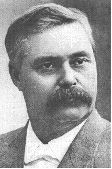 In earlier times, it could not have happened. Today's Broward County is very much a product of the industrial age. The sun and sand and sea have been here for millennia, but the roads, railroads and seaport are new additions which have vastly transformed the area's landscape.
In earlier times, it could not have happened. Today's Broward County is very much a product of the industrial age. The sun and sand and sea have been here for millennia, but the roads, railroads and seaport are new additions which have vastly transformed the area's landscape.
Governor Broward
Until the Florida East Coast (FEC) Railroad was brought through in 1896, the area was accessible to only a hardy few. Until Everglades drainage was begun a decade later, only the coastal ridge and scattered spots of high ground to the west were habitable. Until Port Everglades was opened in the 1920s, there was no dependable anchorage for large ships. This is not to say, however, that Broward is a totally new-made land. The opening quotation from Dr. William Sears, professor of anthropology at Florida Atlantic University, is true only in terms of what today's residents consider necessary. But, prior to the modern era of settlement, small bands of Indians got along very nicely for perhaps 4,000 years.
In fact, the story of man in Broward county may go back even further although we have no firm evidence. Skeletal remains of big-game hunters who lived 10,000 years ago have been found as near as Vero Beach on the east coast and Charlotte Harbor on the west.
When the big-game became extinct, about 8,000 years ago, the Indians turned to a diversified pattern of hunting and gathering and made use of every edible resource they could find. It is Indians of this type, known to archaeologists as "Archaic," who were Broward's first known residents.
They wandered throughout the county at least 2,000 and probably 4,000 years ago. The requirements of their existence --- shell-fish and fish, game such as deer and bear, plants such as seagrape and prickly pear --- kept their settlements small and transitory. The major village of Tequesta, near the mouth of Miami River, probably was not more than a couple of centuries old when the Spanish visited it in 1567.
South Florida Indians had not, in the past, been hospitable to the Spanish. In 1521 the Calusa fatally wounded Ponce de Leon at charlotte Harbor and the Tequesta, as the Spanish called the inhabitants of Dade and Broward Counties, continued the patterns. A mission established on Miami River was abandoned within two years and never revived.
Nevertheless, the Tequesta were on the decline. Some blame it on disease introduced by the Spanish, others on warfare with the stronger Calusa but, whatever the cause, there were only about 80 Indians in southeast Florida in 1763, and they left for Havana when the Spanish ceded Florida to Great Britain at the end of the French and Indian War.
The British held the area for only 20 years, ceding it back to Spain in the Treaty of Paris following the American Revolution. Sometime after the re-establishment of Spanish rule, Broward's first non-Indian settlers arrived.
They were the Lewises: Surlie, Frankee and at least two children; and the Robbinses: Joseph, and his wife and daughter. All, except Mrs. Robbins, were British and all apparently had come from the Bahamas. They lived on the south side of the New River, possible just above the mouth of Tarpon River. Lewis farmed farther upstream.
The Spanish, fearing that the settlers were a fifth column for possible British reoccupation of the peninsula, sent a supply ship on a spying mission in 1793. The visitors recommended that the settlers be removed, but the recommendation apparently was pushed aside as Spain prepared for war with France.
The United States obtained Florida from Spain in 1821. Colonel James Gadsden, who conducted the first survey in 1825 of today's Broward County, was not impressed. A road would be impractical, he wrote, because "the population of the route will probably never be sufficient to contribute to [its maintenance], while the inducements to individuals to keep up the necessary ferries will scarcely ever be adequate."
The Gadsden party reported the presence on New River of two families, headed by William Cooley and David Williams. Cooley raised vegetables for subsistence and processed coontie root into arrowroot starch for cash. Because navigation was a sometime thing through the shifting and shallow New River mouth, it was fortunate that the produce was relatively imperishable.
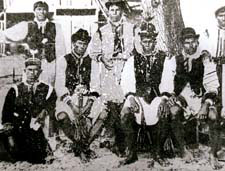 Inland, other newcomers were arriving. They were Seminole Indians, pushed southward by settlers who coveted their rich north Florida pastures. As demands mounted that they be removed to Oklahoma, so did their resentment. On December 28, 1835, they struck, killing Major Francis L. Dade and 104 of his 107 officers and men in an ambush north of Tampa that set off the Second Seminole War.
Inland, other newcomers were arriving. They were Seminole Indians, pushed southward by settlers who coveted their rich north Florida pastures. As demands mounted that they be removed to Oklahoma, so did their resentment. On December 28, 1835, they struck, killing Major Francis L. Dade and 104 of his 107 officers and men in an ambush north of Tampa that set off the Second Seminole War.
On January 6, 1836, a war party descended on the Cooley homestead and killed Mrs. Cooley, the three children and tutor Joseph Flinton. After hearing the victims' screams, the other settlers fled south by land and eventually reached Indian Key where they were joined by Cooley, who had been on a salvage trip.
In March 1838, a force of Tennessee Volunteers and army regulars, commanded by Major William Lauderdale, established a stockade on New River. That fort and a later one built on the beach bore Lauderdale's name.
 Fort Lauderdale House of Refuge
Fort Lauderdale House of Refuge
The war lasted until 1842 but the fear much longer. Those Seminoles who had escaped removal had the area pretty much to themselves for the next 50 years, with only an occasional hunting or exploring party to disturb their solitude. In 1882 the population center of Broward was Pine Island, west of present-day Davie. There, 25 to 30 Seminole families cultivated gardens and from there they roamed the Everglades in search of game.
The first known post-war non-Indian settlers were Washington Jenkins, keeper of the House of Refuge that was built for ship-wrecked sailors in 1876 in the area of the future Birch State Park, and John J. Brown, a pig farmer who won a tainted legislative election that same year and departed for Tallahassee, never to return.
By 1891 there were enough settlers to justify a post office, and two years later came the first of those man-made links with the outside world that would allow Broward to grow. It was the Bay Stage Line, operating over a shell-rock road between Hypoluxo at the south end of Lake Worth and Lemon City, now part of Miami. Passengers on the two-day trip stopped overnight at New River. An Ohioan named Frank Stranahan arrived to run both the overnight camp and the New River ferry.
The coming of the stages also brought to an end the era of the legendary "barefoot mailmen" who, for seven years, had carried the mail from Hypoluxo to Miami by walking along the beach. For five dollars a head, they would let others walk with them.
But, the stages were to be even more short-lived. When Henry M. Flagler learned that Miami was unaffected by the great freeze of February 1895, he decided to extend the FEC south from Palm Beach. On February 22, 1896, the first train reached New River.
Besides making it possible for more settlers to reach Broward, the railroad also made it necessary. If Flagler were to reap any return on the state and private lands which he had been given in return for laying the rails, it was absolutely necessary that he find prospective buyers. His land companies sought immigrants both in the North and in the South.
The were not hard to find. Swedes from the Northeast formed the nucleus of Hallandale, and Danes from the Midwest founded Dania. Southern farmers, lured by better land and milder winters, joined the Danes and Swedes and founded Pompano and Deerfield, besides. Much of the fieldwork was done by blacks from either the South or the Bahamas.
Dania became the area's first incorporated community in 1904, followed by Pompano in 1908 and Fort Lauderdale in 1911. All three pre-date Broward County itself, which was formed from portions of Dade and Palm Beach counties in 1915 and named for former Florida governor Napoleon Bonaparte Broward.
Main Street, Dania, 1912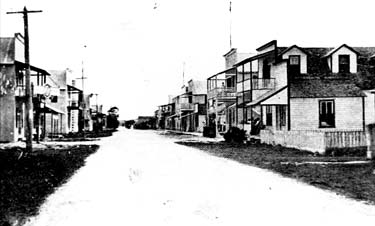 The choice was logical. During his 1905-1909 term as governor, Broward championed Everglades drainage and got the dredges working on the south and north New River canals. While results in the Everglades were mixed, the drainage opened up much of today's urban Broward County for development, first as agricultural land and, later, as residential.
The choice was logical. During his 1905-1909 term as governor, Broward championed Everglades drainage and got the dredges working on the south and north New River canals. While results in the Everglades were mixed, the drainage opened up much of today's urban Broward County for development, first as agricultural land and, later, as residential.
The fruits of this work would come later. With the exception of a flurry in Fort Lauderdale's Progresso area in connection with a 1911 land drawing, growth was slow and steady until the prosperity and optimism that followed World War I set off the first of Broward's two great booms.
In numbers, this boom pales in comparison to the greater one that followed World War II. While the county's population went from 5,135 to 14,242 between 1920 and 1925 for a gain of 9,107, the average gain per year between 1950 and 1970 was 26,808, as the population soared form 83,933 to 620,100.
But numbers are not everything. The 1920s boom set the prevailing pattern in two important ways. First, it marked the advent of the developer city in which a single plan would encompass an entire community rather than a single neighborhood.
Beyond that, it changed the nature of the county's economy. Before 1920 most settlers were farmers, but the newcomers were urban people, many of them retirees. Also, the 1920s witnessed the emergency of tourism as a major facet of the Broward economy.
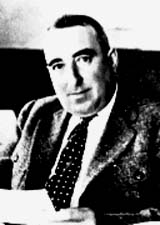 The grandest of the 1920s developers was Joseph W. Young who turned a low-lying tract between Hallandale and Dania into his dream city of Hollywood-by-the-Sea. The lakes, the broad boulevard, the eastern golf course and the traffic circle were all part of Young's master plan. While there have been many developer cities since, none of them, with the possible exception of Coral Springs, started from a plan as grand as Young's.
The grandest of the 1920s developers was Joseph W. Young who turned a low-lying tract between Hallandale and Dania into his dream city of Hollywood-by-the-Sea. The lakes, the broad boulevard, the eastern golf course and the traffic circle were all part of Young's master plan. While there have been many developer cities since, none of them, with the possible exception of Coral Springs, started from a plan as grand as Young's.
To draw residents, he advertised throughout the eastern United States. He brought prospects in by bus, train and ship and treated them to lunch and tours of the city. The he put on the "hard-sell," occasionally utilizing "sweat rooms" where the customer was bombarded by a high-pressure salesman.
Joseph Young
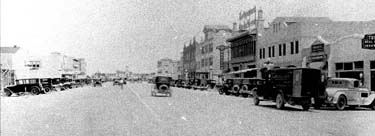 By 1925 the new city was ready for incorporation. That same year, charters were granted to Deerfield, Davie, and Floranada, north of Fort Lauderdale. Early in 1926 Hollywood absorbed both Dania and the unincorporated Hallandale community.
By 1925 the new city was ready for incorporation. That same year, charters were granted to Deerfield, Davie, and Floranada, north of Fort Lauderdale. Early in 1926 Hollywood absorbed both Dania and the unincorporated Hallandale community.
Hollywood Boulevard, 1925 (Mackay Collection)
But the boom already had crested; rough days were ahead. Once more, access to the outside world would be a major problem. With the spate of new settlement, there was a tremendous need for importation of both food and building material, most of which had to be brought over the single-track FEC. Many recognized the problem. Flagler's successors made plans to double-track the FEC and a second railroad, today's Seaboard Coast Line, was extended southward toward Miami. Young and others moved toward creation of Port Everglades.
But, none of this could be done quickly enough. The backlog of goods at Jacksonville so critical that, on October 29, 1925, the FEC had to embargo everything except food or items for which special permits had been obtained.
The effect on construction was catastrophic and this soon was followed by a drying up of credit. Northern banks long had felt that the boom, with its paper-thin operating margins and spiraling prices fed by speculative trading of both property and purchase options, was too giddy to last. By early 1926, they were becoming very cautious with their money.
The most speculative developers were wiped out then and there. Others, including Young, might have been able to weather the downturn, but they could not weather great hurricane that roared out of the Caribbean and smashed squarely into south Broward on September 17 and 18, 1926.
Much of Hollywood was flattened and/or flooded. There were 34 verified deaths. Observers insisted, however, that the real toll was much higher. Damage in Fort Lauderdale was less, but still considerable. Fifteen were dead. North Broward, which had both fewer people and lighter winds, had no deaths and only minor damage.
In the long run, however, the worst damage was done by the black headlines in northern newspapers that scared away potential replacements for those who either had died or fled. For south Florida, the Depression began three years before it hit the rest of the nation.
In 1927 Dania and Hallandale regained their independence, the latter to be its own city for the first time. Davie's charter lapsed, not to be renewed for 35 years, and Floranada, shorn of much of its territory, was reincorporated as Oakland Park. Yet, the collapse was not so total as commonly believed. While the 1930s was not the best of times in Broward, it was not the worst, either. And growth had not stopped, it merely had paused. Population went from the 14,242 of 1925 to 20,094 in 1930 and to 39,794 in 1940.
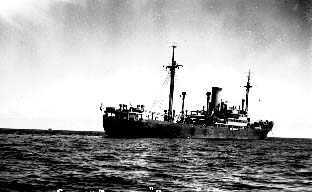 If the Depression had come early to Broward, so did World War II. On December 19, 1939, the British cruiser "Orion" chased the German freighter "Arauca" into Port Everglades, where she remained until 1941 when seized by the United States. The closest the area came to combat was in the week beginning May 4, 1942, when German submarines off southeast Florida torpedoed seven ships, one of which limped into Port Everglades. That, and the landing of four Germans near Jacksonville two months later, led to several countermeasures.
If the Depression had come early to Broward, so did World War II. On December 19, 1939, the British cruiser "Orion" chased the German freighter "Arauca" into Port Everglades, where she remained until 1941 when seized by the United States. The closest the area came to combat was in the week beginning May 4, 1942, when German submarines off southeast Florida torpedoed seven ships, one of which limped into Port Everglades. That, and the landing of four Germans near Jacksonville two months later, led to several countermeasures.
German Freighter "Arauca"
Watch towers were set up along the ocean. The beaches were closed at night and patrolled by mounted Coast Guardsmen with attack dogs. The tops of headlights were blacked out and street lights hooded. Boaters and Civil Air Patrol pilots searched for U-boats.
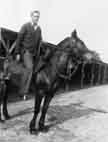 Coast Guardsman R.L. Landers (Landers Collection)
Coast Guardsman R.L. Landers (Landers Collection)
As far as Broward's future was concerned, however, the most significant thing about the war was the plethora of training bases that were established. Every airfield in the county, plus the future site of Broward Community College's central campus was a World War II training facility.
When peace came, thousands of service men recalled how nice it had been in Broward. With their families, they returned. Thousands of others joined them. The greatest boom was on. Even in these days of trillion dollar gross national products, the figures are sobering. In the 30 years from 1940 to 1970, Fort Lauderdale's's population shot from 17,996 to 139,590. Hollywood went from 6,239 to 106,873; Pompano Beach from 4,427 to 38,587; and Hallandale from 1,827 to 23,849. Plantation, which was just getting started in 1950, had grown to 23,523 by 1970.
New cities came into being everywhere and old ones grew. In 1945 the county still had only the seven active municipalities of 1929. Hillsboro Beach had been charter din 1939 but was not active until 1947. Hacienda Village was added in 1946 and Wilton Manors in 1947.
But, the explosion was still to come in the next two decades. Lauderdale-by-the-Sea started it off in 1951, followed by Plantation and Lazy Lake in 1953; Margate and Miramar, 1955; Lighthouse Point, 1956; Pembroke Park, 1957; Lauderhill, Cooper City, Sea Ranch Lakes, and Pembroke Pines, 1959; Sunrise, Davie, and Lauderdale Lakes, 1961; North Lauderdale, Coral Springs, Parkland, and Tamarac, 1963; and Coconut Creek, 1967.
As the county's population soared toward a million, a few of the developers became overextended or came under criticism because of the close ties between their firms and the cities which they had created. Also, a growing number of newcomers feared that too-rapid growth would bring to their new homes those problems which they had left behind in their old ones. As the 1970s dawned, they began demanding that their cities opt for slower growth and lower limits on the number of residences per acre. Gradually, governments began to respond.
Yet, when growth finally paused in 1974 it was not as a result of municipal actions. Instead, south Florida was just one more victim of a recession which was sweeping the nation. It was not the inability to build that cooled the boom. Rather, it was the inability to sell. At one point, there were an estimated 50,000 unsold condominium apartments in the area.
By 1976 the building industry began to revive. With it came a concern that the uncontrolled and, sometimes, unwise growth that characterized the past would not be repeated. A new county charter gave Broward's government broad powers to monitor and improve the quality of life and the environment. The passage of of the 1977 Land Use Plan was a major step toward limiting urban sprawl and insuring that the area's resources, natural, economic and social, would be put to their best use. In short, citizens and leaders had allied in their desire to see that the land once "unfit for human habitation" would not become uninhabitable again.
xxxxxxxxxxxxxxxxxxxxxxxxxxxxxxxxxxxx
Taken from: Broward County web page.


